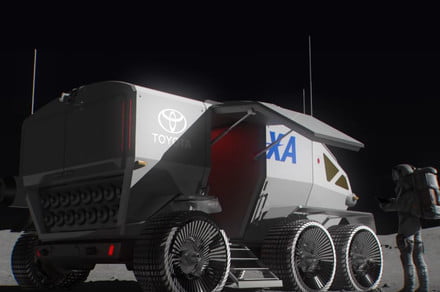[youtube https://www.youtube.com/watch?v=1kd2nFHAAtU?feature=oembed&w=100&h=100]
Toyota announced it will be teaming up with the Japan Aerospace Exploration Agency (JAXA) to design and built a lunar rover. The two organizations aim to collaborate to create a manned, pressurized rover that would be suitable for mobility on the moon.
A big challenge in the design of such rovers is power consumption, as power must either be sent with the rover in the form of heavy fuel, or it must be collected from the lunar environment. The visualization released by Toyota shows a rover with an expandable solar panel for recharging using energy from the sun, and the announcement also made mention of “fuel cell vehicle technologies.”
A visualization of the Toyota moon rover deploying its solar panel.
The use of efficient fuel cells would allow the rover to cruise more than 10,000 kilometers (6,200 miles) across the lunar surface, and the cells are a clean form of power generation which emit only water. The fuel cell technology ties in to Toyota’s ambition to achieve sustainable technologies for Earth-based vehicles as well: “Toyota believes that achieving a sustainable society of mobility on Earth will involve the coexistence and widespread use of electrified vehicles, such as hybrid vehicles, plug-in hybrid vehicles, electric vehicles, and fuel cell vehicles,” Toyota Executive Vice President Shigeki Terashi said in a statement. “For electrification, fuel cell batteries represent an indispensable technology.”
Another challenge faced by the designers of moon rovers is the inhospitable lunar environment, as JAXA Vice President Koichi Wakata commented in the same statement: “Lunar gravity is one-sixth of that on Earth. Meanwhile, the moon has a complex terrain with craters, cliffs, and hills. Moreover, it is exposed to radiation and temperature conditions that are much harsher than those on Earth, as well as an ultra-high vacuum environment. For wide-ranging human exploration of the moon, a pressurized rover that can travel more than 10,000 km in such environments is a necessity.”
Remote controls would make the rover easy to operate for astronauts in suits with limited dexterity.
The specifications of the rover released so far indicate that it would be 6 meters (20 feet) in length and 5.2 meters (17 feet) wide, making it about twice the size of a Volkswagen camper van. Inside will be a total of 13 square meters (140 square feet) of living space, which is fairly generous and is enough to accommodate two people comfortably or four in an emergency. The aim is to launch the rover into space in 2029.
Editors’ Recommendations
- Land Rover’s new 2020 Range Rover Evoque is smart off-road and chic in the city
- After a record-setting 15 years, NASA ends Opportunity rover’s tour of Mars
- Curiosity rover learns a new trick: Measuring the gravity of mountains
- Readying for Mars mission, rover finds clues to life in the Chilean desert
- Curiosity suffered a boot issue but is now back up and roving

